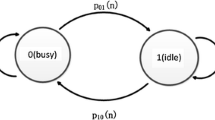Abstract
This paper presents a theoretical analysis of the spectrum utilization levels in a cognitive radio system. We assume that the traffic of the primary network is bursty and asynchronous with the secondary network, which performs imperfect spectrum sensing. Collisions of the primary and the secondary packets are assumed to result in increased packet error probabilities. We present primary and secondary utilization levels under optimized secondary transmission periods for varying primary traffic characteristics and secondary sensing performance levels. The results are also validated by extensive Monte Carlo simulations. We find that an asynchronous cognitive radio network with imperfect spectrum sensing is feasible when optimized transmission periods are used. The effects of primary traffic’s burst pattern and secondary sensing performance are discussed.





Similar content being viewed by others
References
Altrad, O., Muhaidat, S., Al-Dweik, A., Shami, A., Yoo, P.: Opportunistic spectrum access in cognitive radio networks under imperfect spectrum sensing. Trans. Veh. Technol. 63(2), 920–925 (2014)
Bayhan, S., Alagöz, F.: A Markovian approach for best-fit channel selection in cognitive radio networks. Ad Hoc Netw. 12, 165–177 (2014)
Cheng, W., Zhang, X., Zhang, H.: Full-duplex spectrum-sensing and MAC-protocol for multichannel non-time-slotted cognitive radio networks. IEEE J. Sel. Areas Commun. PP(99), 1–1 (2014). doi:10.1109/JSAC.2014.2361078
Cisco Systems Inc.: Cisco visual networking index: forecast and methodology 2013–2018. White paper (2014)
De Domenico, A., Strinati, E.C., Di Benedetto, M.G.: A survey on MAC strategies for cognitive radio networks. IEEE Commun. Surv. Tutor. 14(1), 21–44 (2012)
Epitiro Ltd.: LTE real-World performance study: broadband and voice over LTE (VoLTE) quality analysis. Technical Report, TeliaSonera, Turku, Finland (2011). http://www.slideshare.net/wandalex/lte-real-world-performance-study
Feng, W.J., Jiang, R., Han, P., Liao, W., He, H.: Performance analysis of cognitive radio spectrum access with different primary user access schemes. Wirel. Pers. Commun. 75(1), 309–324 (2014)
Geirhofer, S., Tong, L., Sadler, B.M.: Dynamic spectrum access in the time domain: modeling and exploiting white space. IEEE Commun. Mag. 45(5), 66–72 (2007)
Hong, J., Hong, B., Ban, T.W., Choi, W.: On the cooperative diversity gain in underlay cognitive radio systems. IEEE Trans. Commun. 60(1), 209–219 (2012). doi:10.1109/TCOMM.2011.101411.100677
Katayama, H., Masuyama, H., Kasahara, S., Takahashi, Y.: Effect of spectrum sensing overhead on performance for cognitive radio networks with channel bonding. J. Indus. Manag. Optim. 10(1), 21–40 (2014)
Lee, J., Wang, H., Andrews, J., Hong, D.: Outage probability of cognitive relay networks with interference constraints. IEEE Trans. Wirel. Commun. 10(2), 390–395 (2011). doi:10.1109/TWC.2010.120310.090852
Liu, G., Zhu, X., Hanzo, L.: Dynamic spectrum sharing models for cognitive radio aided ad hoc networks and their performance analysis. In: Proceedings of IEEE GLOBECOM conference, pp. 1–5. IEEE (2011)
Oklander, B., Sidi, M.: On cognitive processes in cognitive radio networks. Wirel. Netw. 20(2), 319–330 (2014)
Parsaeefard, S., Sharafat, A.: Robust worst-case interference control in underlay cognitive radio networks. IEEE Trans. Veh. Technol. 61(8), 3731–3745 (2012). doi:10.1109/TVT.2012.2205719
Shah, G.A., Akan, O.B.: Performance analysis of CSMA-based opportunistic medium access protocol in cognitive radio sensor networks. Ad Hoc Netw. 15(4), 4–13 (2014)
Wang, B., Ji, Z., Liu, K.R., Clancy, T.C.: Primary-prioritized Markov approach for dynamic spectrum allocation. IEEE Trans. Wirel. Commun. 8(4), 1854–1865 (2009)
Wang, B., Liu, K.J.R.: Advances in cognitive radio networks: a survey. IEEE J. Sel. Top. Signal Process. 5(1), 5–23 (2011)
Wong, E., Foh, C.: Analysis of cognitive radio spectrum access with finite user population. IEEE Commun. Lett. 13(5), 294–296 (2009)
Zahmati, A., Fernando, X., Grami, A.: Steady-state Markov chain analysis for heterogeneous cognitive radio networks. In: Proceedings of the IEEE Sarnoff Symposium, pp. 1–5 (2010)
Zhao, H., Gao, H., Liang, X., Mu, X.: Joint design of spectrum sensing and data transmission for cognitive radio networks. In: Proceedings of 6th International Conference on Biomedical Engineering and Informatics, pp. 792–796. IEEE (2013). doi:10.1109/BMEI.2013.6747048
Author information
Authors and Affiliations
Corresponding author
Additional information
This work has been partially supported by European Commission Grant No. PIRG06-GA-2009-256326 and TUBITAK Grant No. 114E739.
Rights and permissions
About this article
Cite this article
Ercan, A.Ö. Analysis of asynchronous cognitive radio system with imperfect sensing and bursty primary user traffic. SIViP 10, 593–600 (2016). https://doi.org/10.1007/s11760-015-0782-4
Received:
Revised:
Accepted:
Published:
Issue Date:
DOI: https://doi.org/10.1007/s11760-015-0782-4




